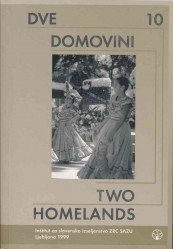Slovene Identity in Venezuela
Abstract
Among the countries of South America to which large numbers of Slovenes have emigrated, Venezuela is perhaps the most modestly represented in the otherwise relatively extensive literature on Slovene emigration, and only a few articles are to be found on Venezuela either in periodical publications or in specialist or academic literature. For this reason the author decided to make an 18-day visit to Venezuela, during the course of which he met 22 families and spoke with 71 members of the first, second and third generations of immigrants. He spent most time with the family of Tončka Brundula, the president of the Slovene Society of SS Cyril and Methodius in Caracas. After having compared written statements and oral testimony, the author estimates that around 600 Slovenes came to Venezuela and remained there. The majority arrived in 1947, while others continued to arrive gradually until 1960, when immigration from the Slovene ethnic territory more or less came to a halt. Slovenes in Caracas began coming together for communal events as early as 1952, while in 1966 the Cyril and Methodius Society mentioned above was founded. The various events are always attended by around 150 people of Slovene origin (of different generations) and their non-Slovene family members.
Among the second generation, in which the author is most interested, the Slovene language is mainly present among children of Slovene parents, while in most other cases it has partly or completely disappeared. In most cases we can talk about an ‘identification’ identity, i.e. a recognition in principle of Slovene ethnic roots and occasional interest in Slovene matters.
The author fin s that following the death of the Slovene priest Monsignor Janez Grilc in 1997, the Slovene community in Venezuela has found itself at a turning point. It has been left without a spiritual leader and organizer, and without a fresh consolidation; i f the society does not start operating again, the already fairly weak links connecting the dispersed community will be broken, which could lead to accelerated assimilation and the complete disappearance of a Slovene identity.
Downloads
References
Caballero, Oswaldo Feo. 1997. El Trompillo. Valencia: Ediciones del Gobierno de Carabobo.
Grilc, Janez. 1970. Venezuela in Slovenci. K oledar-Zbornik Svobodne Slovenije 1970, Buenos Aires: Svobodna Slovenija, str. 227-228.
Grilc, Janez. 1975. O Slovencih v Venezueli. Koledar - Zbornik Svobodne Slovenije 1973-1975, Buenos Aires: Svobodna Slovenija, str. 461-463.
Pravila Društva Sv. Cirila in Metoda, Caracas, 8. maj 1966. (Arhiv Društva Sv. Cirila in Metoda.)
Russel, Bernard. 1991. Research Methods in Cultural Anthropology. Newbury Park, London, New Delhy: Sage Publications.
N.N. Venezuela - Akcija za Slovenski dom. 1967. K oledar-Z bornik Svobodne Slovenije 1967, Buenos Aires: Svobodna Slovenija, str. 4 2 4 -4 2 5 .
N.N. Venezuela - Akcija za Slovenski dom. 1967. K oledar-Z bornik Svobodne Slovenije 1967, Buenos Aires: Svobodna Slovenija, str. 4 2 4 -4 2 5 .
Žigon, Zvone. 1998 a. Maša z bobni (intervju z Antonom Flugom Delčnjakom). Dnevnik, št. 331/XXXVII, 6. december, str. 24.
Žigon, Zvone. 1998 b. Otroci dveh domovin: Slovenstvo v Južni Ameriki. Ljubljana: Založba ZRC.
Žigon, Zvone. 1998 c. Pri Slovencih v Venezueli. Rodna gruda, št. 12, str. 40- 41.
Downloads
Published
How to Cite
Issue
Section
License

This work is licensed under a Creative Commons Attribution-NonCommercial-NoDerivatives 4.0 International License.
Authors guarantee that the work is their own original creation and does not infringe any statutory or common-law copyright or any proprietary right of any third party. In case of claims by third parties, authors commit their self to defend the interests of the publisher, and shall cover any potential costs.
More in: Submission chapter





